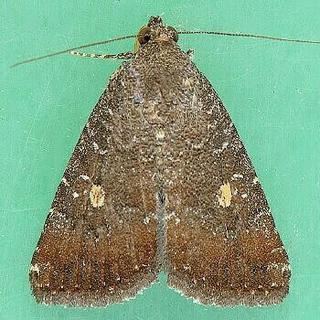Family Erebidae | Subfamily Boletobiinae Rank Species | |
 | ||
Similar Amyna, Polydesma umbricola, Anticarsia irrorata, Ozarba, Megalorhipida leucodactyla | ||
The Eight-Spot (Amyna axis) is a moth of the Erebidae family.
Contents
Distribution
It is found in the tropics and subtropics worldwide, and occurs in Africa, India, Sri Lanka, Indonesia. Australia and the Cook Islands.
The moth migrates north each year in late summer and fall. It is common in southern North America, from Florida to Arizona. It is a regular migrant to the mid-eastern states, and rarely as far as Wisconsin, Ontario and Quebec.
Food plants
The larvae feed on Amaranthus, Croton, Celosia, Digera, Helianthus, Chenopodium, Spinacia, Ipomoea, Ricinus, Arachis, Crotalaria, Medicago, Phaseolus, Hibiscus, Cardiospermum, Solanum, Corchorus and Parasponia species.
It is an irregular minor pest worldwide of mung beans (Vigna radiata), black-eyed peas (Vigna unguiclata), lucerne (Medicago sativa) and soy beans (Glycine max). Their prevalence may be under-reported due to the resemblance of the caterpillar with those of Chrysoieixis species.
Early stages
The larva are thin-bodied and have faint white stripes and two pairs of ventral pro-legs. At low densities of groups, caterpillars are pale green. Among caterpillars at high densities, there are higher frequencies of melanistic phenotypes. The degree of blackening varied widely, ranging from individuals with simple subdorsal-lateral patches to those that were mostly black.
Larvae perch on the undersides of leaves and along stems and petioles. At rest, the abdominal segments are often looped upward. When alarmed the larva essentially jumps from the host and continues to wreathe and wriggle wildly. Prepupal larvae take on a pinkish cast. Pupation occurs in a silken cocoon below (usually) or at the soil surface. Sand and/or plant debris are interwoven into the cocoon wall.
Adult
The adult moth is chocolate brown above and has a wingspan of 20–25 mm (0.79–0.98 in). The forewings have faint greyish-white lines and an obscure figure-of-eight mark on it. The hindwings are lighter with fainter markings. The male can be differentiated by the presence of a small semi-transparent patch on each wing. Adults are on wing from August to October. Forewing of male with a small vesicle in cell, with a small valve of scales over it on underside, the median nervure being slightly curved. Smaller than Amyna punctum.
